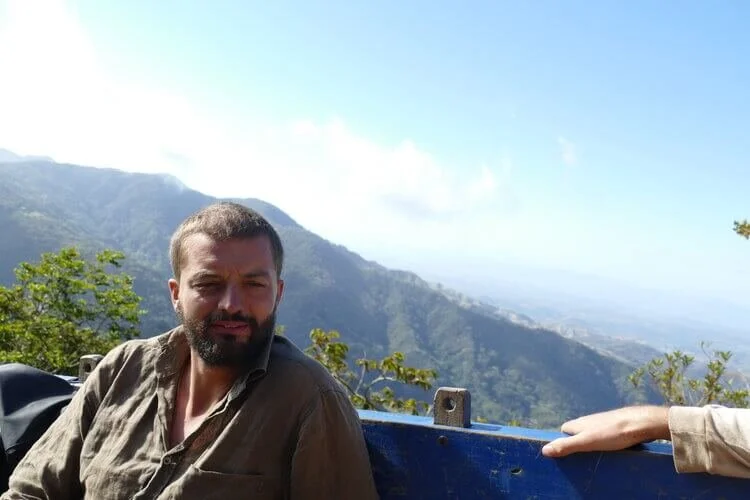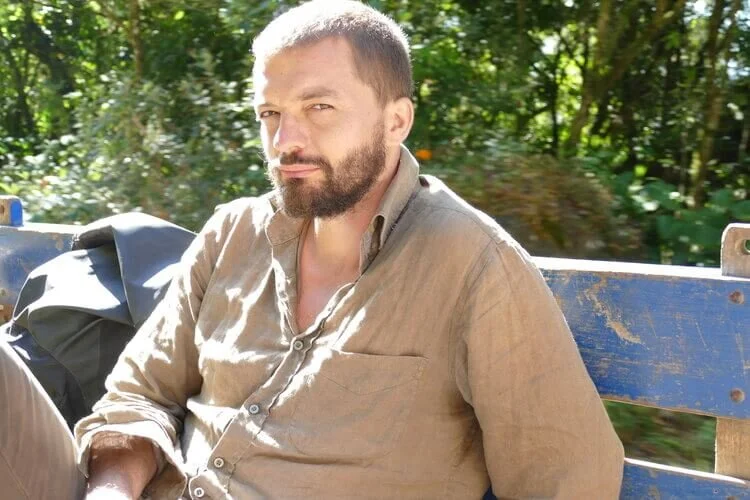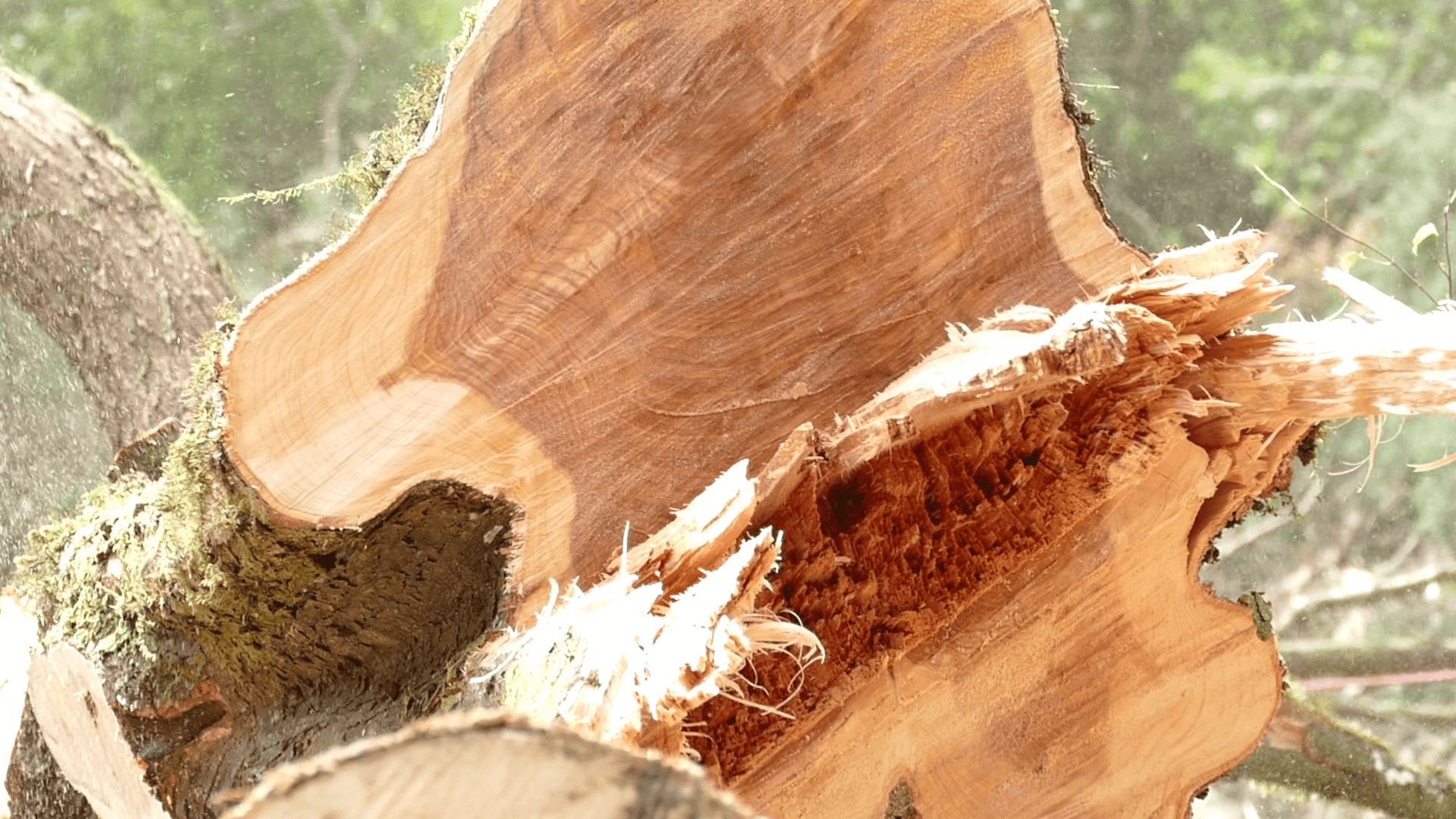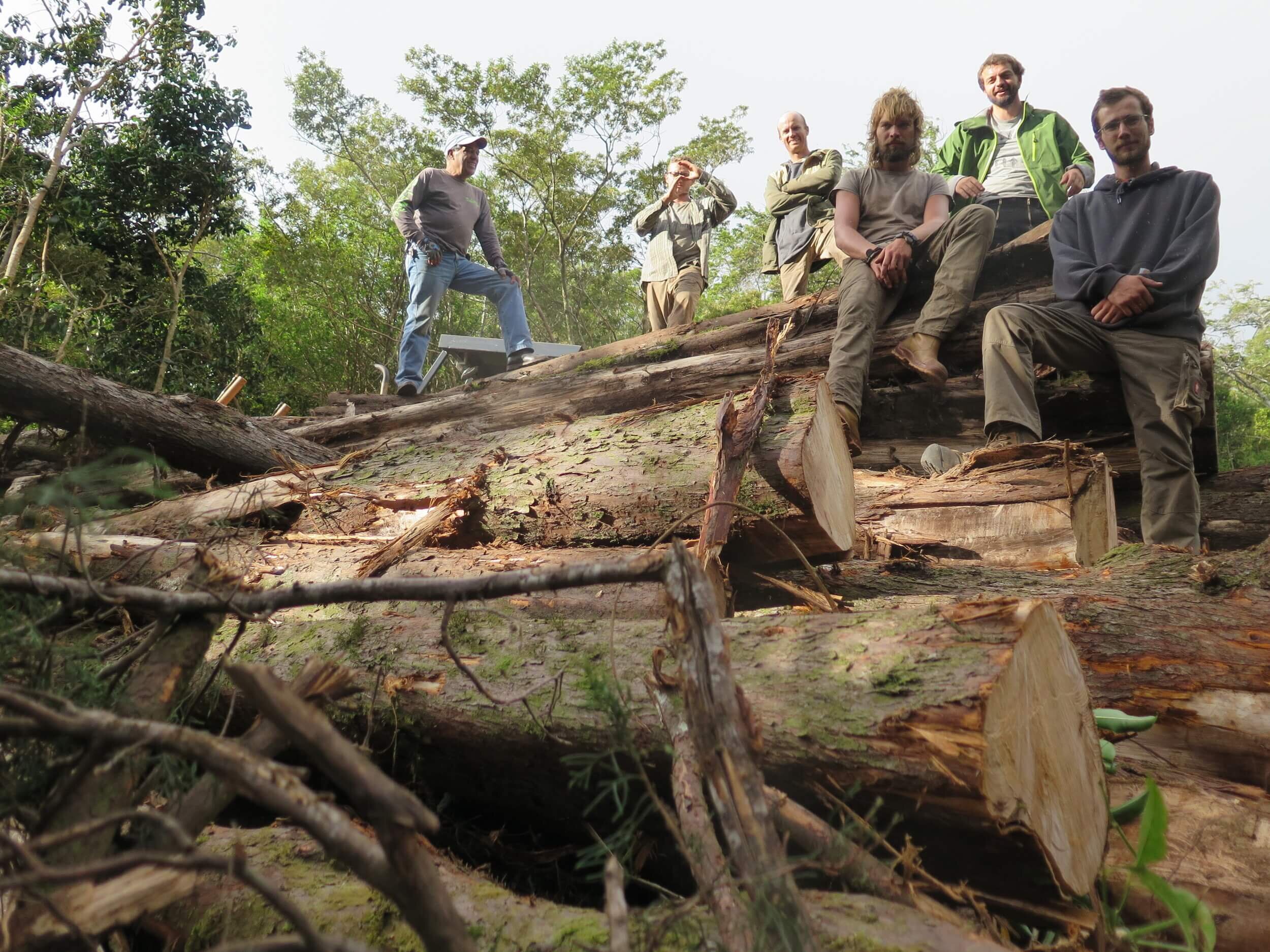From Clouds to Mangrove
Adrien working on the first frames of Ceiba, made from Cedro Amargo (Spanish Cedar). Photo: Jeremy Starn
7:00 am, the truck is leaving the coast and starts climbing the first heights of the steep Monteverde (Green Mountain). The truck is shaking on her back half a dozen chainsawyers ready to go. For many kilometers now the road isn’t asphalted anymore, and I bet the rainy season’s landslides are the cause of this annoyance. “No, no” replies Lynx “The Road Maintenance funding has been released twice, but never reaches the worksite”. Costa Rica is like a tiny Switzerland, but still smells like third-world.
Adrien with the San Luis Valley and blur of the Pacific Ocean in the background. Photo: Finn Richardson
Adrien in the back of “Buckie”. Photo: Finn Richardson
Adrien enjoying the wind in the back of the truck. Photo: Finn Richardson
We abandon Santa Elena and its “eco-tourists” to get further through the cloud-forest. On our left-hand side non-native Cypress trees are lining up as wind breakers and on our right-hand side a high-voltage electric line. These very branchy trees are good for medium quality lumber and are reserved for scaffoldings, staging and bracing. We need to maximise our harvest, but watch out for the power line! The lumberjack’s ground to air ballet is about to begin; I’m climbing as high as possible to fix rigging to the main branch. The Canadian, JT, is setting up the pulley system, skilfully tightening the rope to the opposite side of the road. Then Fred starts cutting the wooden fibres with the 150 cm long saw blade following the sequence : risk assessment, escape route, trajectory, target, notch, horizontal cut, fall and crash. At the end of the day, he shares his feeling with us : “Guys... I f****n’ love my job”. Applause. Curtain!
Adrien & JT cutting down large cypress with a STIHL chainsaw. Photo: Finn Richardson
“These very branchy trees are good for medium quality lumber and are reserved for scaffoldings, staging and bracing.”
Our B&B is nestled in the nook of an adjacent valley in San Luis. It’s a building made out of wavy logs filled with earth and straw – the heart of the first Biodynamic coffee farm in the area, and Ceiba’s partnership from the beginning. This thick jungle is hiding Puma and Sloth, and it has been parsimoniously thinned to welcome the young plants. Centenary Ficus, Lemon tree and Plantain banana trees are sheltering the coffee bushes. By clear weather we are able to catch a sight of the shipyard at the end of Punta Morales’s tiny Peninsula. If everything goes well, in three years time, Noam the farm-manager will be able to see from his home the vessel loaded with precious beans departing for Vancouver.
A big cypress mid-fall on its way down. Photo: Finn Richardson
“If everything goes well, in three years time, Noam the farm-manager will be able to see from his home the vessel loaded with precious beans departing for Vancouver.”
A few days later, back on the coast, a heavyweight truck arrives at the yard, filled to breaking point with logs and her escort of solid Ticos and breaks the sweet routine of the “Yardies”. After a quick and efficient unloading with only a lever bar, the new master saw-miller Luuk and his American mobile saw enters the fray for five days non-stop. The freshly cut timbers are used as soon as they appear. At the end of the week, the secondary architecture required to assemble and erect the ship frames is complete and operational.
Cut cypress in the sunlight.
“The freshly cut timbers are used as soon as they appear. At the end of the week, the secondary architecture required to assemble and erect the ship frames is complete and operational.”
I’ve been practising woodwork for seven years now, especially inland framing - first as a journeyman and now with my own company. Ancient techniques and creativity are the pepper and the salt of my trade. As a landlubber, boat building remained hidden from my sight until I heard about SAILCARGO INC. Here I am surrounded by more than fifteen different trades. I feel like receiving as much as I’m giving. Delightfully nourishing.
Long Live Ceiba!
If you are interested in helping us continue to reach our goals with the construction of Ceiba and see this beautiful tallship enter the Pacific on schedule, consider becoming an investor and get in touch with us TODAY - simply click the button below to find out more.
Our project is funded entirely by people like you becoming shareholders through investing. Support the change you wish to see in the world by getting involved with us here @SAILCARGO INC.
Together, we can #SeaShippingChange
Des Nuoges á la Mangrove
From time to time, yardies drive up in the mountains of Monteverde to cut trees. Adrien shares his experience of sleeping on a local coffee farm and of contributing a part to the project through his woodworking.
Adrien & Silas position a section of Frame 47/48 on the saw-horses for shaping. Photo: Jeremy Starn
7h du matin, le camion quitte la côte et attaque les premiers dénivelés des abruptes Monteverde (Montagnes vertes). Il brinquebale dans son arrière une demi-douzaine de féru de scie à chaine prêt à en découdre. La route n’est plus asphaltée depuis des kilomètres, je parie sur les nombreux glissements de terrains de la saison des pluies pour excuser ce désagrément. “Non non” me réponds Lynx, “L’argent des travaux a été débloqué deux fois mais n’a jamais atteint le chantier”. Costa Rica : petite suisse parfum tiers-monde.
Nous délaissons Santa Helena et ses “éco-touristes” pour nous engouffrer plus loin dans la foret de nuages. Sur notre gauche s’aligne une rangée de Cyprès “wind-breaker”, espèce introduite, et à notre droite une ligne à haute tension. Ces bois très branchus, de second et troisième choix deviendront échafaudage, étayage et aire d’épure. Il nous en faut un Max, mais gare à la ligne …
Adrien uses the STIHL chainsaw to cut through a giant felled cypress. Photo: Finn Richardson
Le ballet sol-air du bucheron peut commencer : je grimpe aussi haut que possible, arrime une branche principale, JT, le canadien moufle et tensionne savamment l’amarre à l’opposé de la route, puis Fred entame les fibres avec le long guide de 150 cm selon la coutume : évaluation des risques, voie de secours, trajectoire, encoche, coupe horizontale, chute et fracas. En fin de journée, il nous partage son sentiment : « Guys, I f****n’ love my job. » Applaudissements. Rideau !
Red on red - sitting on top of the latest delivery of cypress. Photo: Finn Richardson
“Ces bois très branchus, de second et troisième choix deviendront échafaudage, étayage et aire d’épure.”
Notre gite étape est niché dans le recoin d’une vallée adjacente à San Luis. C’est un bâtiment de bois tordu et de terre paille toute en courbes, fief de l’unique plantation de café en biodynamie de la région et partenaire de la première heure de Ceiba. L’épaisse jungle servant de couvert au puma et au paresseux a été parcimonieusement éclairci pour accueillir les jeunes plants. Ficus centenaires, bananiers et citronnier abritent les caféiers. Par temps dégagé nous apercevons, le chantier au bout de la langue de sable de Punta Morales. Si tout va bien, dans trois ans, Noam, le gérant, verra depuis chez lui le trois mâts chargé de ses précieux grains en partance pour Vancouver.
“Si tout va bien, dans trois ans, Noam, le gérant, verra depuis chez lui le trois mâts chargé de ses précieux grains en partance pour Vancouver.”
The latest delivery of cypress, ready to be lifted off with steel bars, and milled by Luuk on the WoodMizer. Photo: Finn Richardson
Team-work to lift the giant logs off the back of the truck. Photo: Finn Richardson
In action - the cypress logs are tossed almost effortlessly off the truck. Photo: Finn Richardson
Quelques jours plus tard de retour sur la côte, un poids-lourd plateau plein à craquer de rondins et son escorte d’armoires à glaces Tycos vient rompre la routine bien huilée des “yardies”. Après un déchargement à la barre à mine expédié, Luuk nouveau maitre scieur et sa scie mobile américaine entrent en lice pour cinq jours continus. Dès qu’un madrier voit le jour il est de suite employé. A la fin de la semaine l’architecture secondaire nécessaire à la fabrication et à l’érection des membrures (les côtes du bateau) est opérationnelle.
“A la fin de la semaine l’architecture secondaire nécessaire à la fabrication et à l’érection des membrures (les côtes du bateau) est opérationnelle.”
Fred & Luuk on the WoodMizer, which milled all of the cypress delivered. Photo: Finn Richardson
J'explore depuis sept ans le travail du bois. Au début en itinérance dans différentes entreprises et collectifs puis j'ai démarré ma propre entreprise spécialisée en charpente traditionnelle. Techniques anciennes et recherche esthétique sont le sel et le poivre de ma pratique. J'ai eu la chance d’être invitée sur un trois-mats par un ami pour une traversée de la Manche, c'est la qu'il m'a parlé de SAILCARGO INC. Me voici, entourée par une quinzaine de métiers : charpentiers de marine, sculpteurs, ébénistes, etc. J'ai le sentiment de recevoir autant que je donne. Délicieusement nourrissant.
Longue vie à Ceiba.
Adrien & Silas carry a newly-cut cypress board to continue the framing stage. Photo: Finn Richardson
The end result - cypress has cross-beam planks for the framing stage of Ceiba. Photo: Finn Richardson
The team at the end of the day’s work - a successful load of cypress ready to be transported down to the shipyard.
If you are interested in helping us continue to reach our goals with the construction of Ceiba and see this beautiful tallship enter the Pacific on schedule, consider becoming an investor and get in touch with us TODAY - simply click the button below to find out more.
Our project is funded entirely by people like you becoming shareholders through investing. Support the change you wish to see in the world by getting involved with us here @SAILCARGO INC.
info@sailcargo.org
Together, we can #SeaShippingChange

















